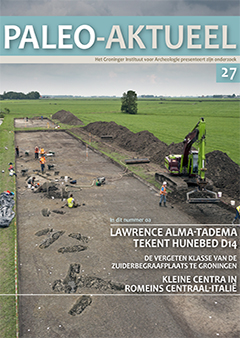Ruim 2200 jaar terug in de tijd: het terpzoolonderzoek te Schettens-Sotterum 2015
Samenvatting
Over 2200 years of history: the excavation of Schettens-Sotterum 2015. In the late summer of 2015 the Groningen Institute of Archaeology excavated the remnants of the man-made dwelling mound (terp) of the hamlet of Sotterum near the city of Bolsward (province of Fryslân). Preliminary results show that the site was first settled around 200 BC and that by the start of the Roman Iron Age it had developed into a small settlement with rectangular parcelling. During the Migration Period and the Early Middle Ages habitation was probably sparse: around the mound, multiple flood deposits dating to this period indicate that the landscape was probably too wet. In the High Middle Ages and onwards, a somewhat round terp underlay the hamlet. The Late Middle Ages presumably saw a predecessor of the notable farmstead ‘Osinga-state’ built on the southeastern edge of the terp. During this period, rather late compared to other terp sites in this area, the settlement of Sotterum took its eventual shape. Subsequently in the 16th century ‘Osinga-state’ probably was moved to its current location just next to the terp. Ultimately the dwelling mound was quarried for its fertile soil at the end of the 19th century. Even though the terp had been dug away, it still proved possible to reconstruct the development of the settlement and the terp; moreover, research shows that even quarried and vanished terp sites are archaeological treasuries.

